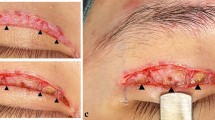Abstract
Background
Injection of local anesthetics into the upper and lower eyelids is routinely performed during a variety of common surgical procedures, including cosmetic blepharoplasty. Although skeletal muscle injury is a very well documented side effect of virtually all local anesthetics, there are few reported cases of orbicularis myotoxicity despite its common exposure to periocular injections. Post-operative localized and occasionally persistent orbicularis oculi weakness may be presumably attributable to local anesthetic myotoxicity.
Methods
A non-randomized retrospective clinical case series identified 32 patients seen in a tertiary care referral oculoplastic practice over a 7-year period. Follow-up ranged from 0.5 to 7 years with an average of 1.3 years.
Results
Patients demonstrated varying degrees and duration of orbicularis oculi dysfunction manifesting primarily as lagophthalmos. Although most patients improved with observation alone, 6 of 32 patients did not.
Conclusions
Orbicularis oculi dysfunction may result from local anesthetic injections. In most cases, this complication is transient, yet permanent dysfunction can occur. To minimize the risk of developing this complication, local anesthetics should be judiciously administered in low volume and concentration away from the critical pretarsal orbicularis. Additionally, patients should be counseled preoperatively about the potential risks of local anesthetic use.
Level of Evidence: Level IV, prognostic / risk study.
Similar content being viewed by others
References
Foster AH, Carlson BM (1980) Myotoxicity of local anesthetics and regeneration of the damaged muscle fibers. Anesth Analg 59(10):727–736
McLoon LK, Wirschafter J (1993) Regional differences in the subacute response of rabbit orbicularis oculi to bupivacaine-induced myotoxicity as quantified with a neural cell adhesion molecule immunohistochemical marker. Invest Ophthalm Vis Sci 34(12):3450–3458
Hogan Q, Dotson R, Erickson S et al (1994) Local anesthetic myotoxicity: a case and review. Anesthesiology 80:942–947
Rainin EA, Carlson BM (1985) Postoperative diplopia and ptosis: a clinical hypothesis based on the myotoxicity of local anesthetics. Arch Ophthalm 103(9):1337–1339
Gomez-Arnau JI, Yanguela J, Gonzalez A et al (2003) Anaesthesia-related diplopia after cataract surgery. Br J Anaesth 90:189–193
Abell KM, Cowen DE, Baker RS, Porter JD (1999) Eyelid kinematics following blepharoplasty. Ophthal Plast Reconstr Surg 15:236–242
Brun A (1959) Effect of procaine, carbocaine, and xylocaine cutaneous muscle in rabbits and mice. Acta Anesthesiol Scand 3:59–73
Pizzolato P, Mannheimer W (1954) Mode of action and effects of long acting local anesthetics. J Am Med Assoc 154(1):29–32
Carlson BM, Emerick S, Komorowski TE, Rainin EA (1992) Extraocular muscle regeneration in primates: local anesthetic induced lesions. Ophthalmol 99:582–589
Oklund S, Komorowski TE, Carlson BM (1989) Ultrastructure of mepivacaine induced damage and regeneration in rat extraocular muscle. Invest Ophthalmol Vis Sci 30:1643–1651
Benoit PW (1978) Reversible skeletal muscle damage after administration of local anesthetics with and without epinephrine. J Oral Surg 36:198–201
Yagiela JA, Benoit PW, Fort NF (1982) Mechanism of epinephrine enhancement of lidocaine-induced skeletal muscle necrosis. J Dent Res 61(5):686–690
McLoon LK, Wirtschafter J (1998) Time course of the regenerative response in bupivacaine injured orbicularis oculi muscle. Cell Tissue Res 294:439–447
Irwin W, Fontaine E, Agnolucci L et al (2002) Bupivacaine myotoxicity is mediated by mitochondria. J Biol Chem 277(14):12221–12227
Komai H, Lokuta AJ (1999) Interaction of bupivacaine and tetracaine with the sarcoplasmic reticulum calcium release channel of skeletal and cardiac muscles. Anesth 90:835–843
Louboutin JP, Fichter-Gegnepain V, Noireaud J (1996) External calcium dependence of extensor digitorium longus muscle contractility during bupivacaine induced regeneration. Muscle Nerve 19:994–1002
Rosenblatt JD, Woods RI (1992) Hypertrophy of rat extensor digitorium longus muscle injections with bupivacaine. A sequential histochemical, immunohistochemical, histological and morphometric study. J Anat 181:11–27
Benoit PW, Belt WD (1970) Destruction and regeneration of skeletal muscle after treatment with a local anesthetic, bupivacaine. J Anat 107:547–556
Acknowledgments
The authors acknowledge no proprietary interest or financial support.
Conflict of interest
None.
Author information
Authors and Affiliations
Corresponding author
Rights and permissions
About this article
Cite this article
McFate, J.A., Soparkar, C.N.S., Sami, M. et al. Local anesthetic orbicularis myotoxicity: a possible unrecognized cause of post-blepharoplasty lagophthalmos. Eur J Plast Surg 37, 201–204 (2014). https://doi.org/10.1007/s00238-013-0924-2
Received:
Accepted:
Published:
Issue Date:
DOI: https://doi.org/10.1007/s00238-013-0924-2




